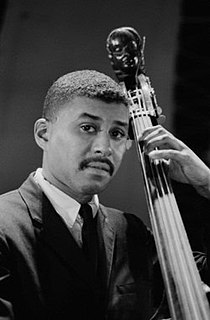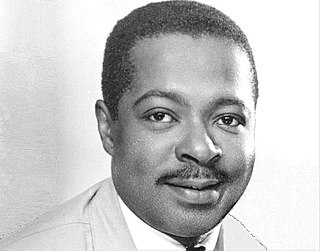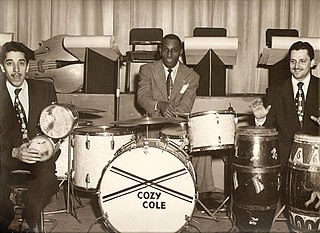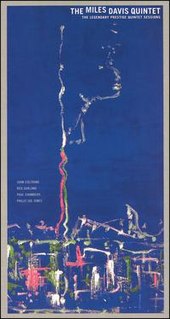Related Research Articles

Blue Note Records is an American jazz record label owned by Universal Music Group and operated under Capitol Music Group. Established in 1939 by Alfred Lion and Max Margulis, it derived its name from the blue notes of jazz and the blues. Originally dedicated to recording traditional jazz and small group swing, the label switched its attention to modern jazz around 1947.

Donaldson Toussaint L'Ouverture Byrd II was an American jazz and rhythm & blues trumpeter and vocalist. A sideman for many other jazz musicians of his generation, Byrd was known as one of the rare bebop jazz musicians who successfully explored funk and soul while remaining a jazz artist. As a bandleader, Byrd was an influence on the early career of Herbie Hancock.

James Oscar Smith was an American jazz musician whose albums often charted on Billboard magazine. He helped popularize the Hammond B-3 organ, creating a link between jazz and 1960s soul music.

Callen Radcliffe Tjader, Jr. was an American Latin jazz musician, known as the most successful non-Latino Latin musician. He explored other jazz idioms, even as he continued to perform the music of Cuba, the Caribbean, Mexico and Latin America.

Theodore Shaw Wilson was an American jazz pianist. Described by critic Scott Yanow as "the definitive swing pianist", Wilson's sophisticated and elegant style was featured on the records of many of the biggest names in jazz, including Louis Armstrong, Lena Horne, Benny Goodman, Billie Holiday, and Ella Fitzgerald. With Goodman, he was one of the first black musicians to appear prominently with white musicians. In addition to his extensive work as a sideman, Wilson also led his own groups and recording sessions from the late 1920s to the 1980s.

Paul Laurence Dunbar Chambers Jr. was a jazz double bassist. A fixture of rhythm sections during the 1950s and 1960s, his importance in the development of jazz bass can be measured not only by the extent of his work in this short period, but also by his impeccable timekeeping and intonation, and virtuosic improvisations. He was also known for his bowed solos. Chambers recorded about a dozen albums as a leader or co-leader, and as a sideman, notably as the anchor of trumpeter Miles Davis's "first great quintet" (1955–63) and with pianist Wynton Kelly (1963–68).

St. Elmo Sylvester Hope was an American jazz pianist, composer, and arranger, chiefly in the bebop and hard bop genres. He grew up playing and listening to jazz and classical music with Bud Powell, and both were close friends of another influential pianist, Thelonious Monk.

Explorations is an album by jazz pianist Bill Evans that was originally released on Riverside label in 1961. The album won the Billboard Jazz Critics Best Piano LP poll for 1961.

Columbus Calvin "Duke" Pearson Jr. was an American jazz pianist and composer. Allmusic describes him as having a "big part in shaping the Blue Note label's hard bop direction in the 1960s as a record producer."

Wynton Charles Kelly was an American jazz pianist and composer. He is known for his lively, blues-based playing and as one of the finest accompanists in jazz. He began playing professionally at the age of 12 and was pianist on a No. 1 R&B hit at the age of 16. His recording debut as a leader occurred three years later, around the time he started to become better known as an accompanist to singer Dinah Washington, and as a member of trumpeter Dizzy Gillespie's band. This progress was interrupted by two years in the United States Army, after which Kelly returned to Washington and Gillespie, and played with other leaders. Over the next few years, these included instrumentalists Cannonball Adderley, John Coltrane, Hank Mobley, Wes Montgomery, and Sonny Rollins, and vocalists Betty Carter, Billie Holiday, and Abbey Lincoln.

Richard Powell was an American jazz pianist, composer, and arranger. He was not assisted in his musical development by Bud, his older and better known brother, but both played predominantly in the bebop style.
Edwin James Costa was an American jazz pianist, vibraphonist, composer and arranger. In 1957 he was chosen as Down Beat jazz critics' new star on piano and vibes – the first time that one artist won two categories in the same year. He became known for his percussive, driving piano style that concentrated on the lower octaves of the keyboard.

Raphael Homer "Ray" Bryant was an American jazz pianist, composer, and arranger.

William Randolph "Cozy" Cole was an American jazz drummer who had hits with the songs "Topsy I" and "Topsy II". "Topsy II" peaked at No. 3 on the Billboard Hot 100, and at No. 1 on the R&B chart. It sold over one million copies and was awarded a gold disc. The track peaked at No. 29 in the UK Singles Chart in 1958. The recording contained a long drum solo and was one of the few drum solo recordings to make the charts at Billboard magazine. The single was issued by Love Records, a small record label in Brooklyn, New York. Cole's song "Turvy II" reached No. 36 in 1959.

Jonathan David Samuel Jones was an American jazz drummer. A band leader and pioneer in jazz percussion, Jones anchored the Count Basie Orchestra rhythm section from 1934 to 1948. He was sometimes known as Papa Jo Jones to distinguish him from younger drummer Philly Joe Jones.

Money Jungle is a studio album by pianist Duke Ellington with double bassist Charles Mingus and drummer Max Roach. It was recorded on September 17, 1962, and released in February 1963 by United Artists Jazz. All but one of the compositions were written by Ellington, with four of the seven on the original LP being recorded for the first time on this album. Later releases on CD added eight tracks from the same recording session.

Julian Clifford Mance, Jr. is an American jazz pianist and composer.
Sam Lazar was an American pianist and Hammond organist originally from St. Louis, Missouri, United States. A mysterious figure who disappeared from the music scene in the early 1960s, he is best known for fronting a group that included early work from guitarist Grant Green. Lazar's career was heavily influenced by fellow organist Jimmy Smith.

The Legendary Prestige Quintet Sessions is a four compact disc box set of recordings by the Miles Davis Quintet released in 2006 by the Concord Music Group. It collates on three discs the entire set of recordings that made up the Prestige Records albums released from 1956 through 1961 — Miles, Cookin', Relaxin', Workin', and Steamin'. The track "'Round Midnight" was released on the album Miles Davis and the Modern Jazz Giants. The fourth disc contains live material from a television broadcast and in jazz club settings. It peaked at #15 on the Billboard jazz album chart, and was reissued on December 2, 2016, in a smaller compact disc brick packaging.

The Jazz Messengers were a jazz combo that existed for over thirty-five years beginning in the early 1950s as a collective, and ending when long-time leader and founding drummer Art Blakey died in 1990. Blakey led or co-led the group from the outset. "Art Blakey" and "Jazz Messengers" became synonymous over the years, though Blakey did lead non-Messenger recording sessions and played as a sideman for other groups throughout his career.
"Yes sir, I'm gonna to stay with the youngsters. When these get too old, I'm gonna get some younger ones. Keeps the mind active."
References
- ↑ Who's Who in Entertainment. Marquis Who's Who. 1989. p. 271. ISBN 9780837918501.
- 1 2 Callahan, Mike; Edwards, David; Preuss, Peter (April 23, 2003). "MGM Album Discography, Part 4: E-3401 to E-3600 (1956-1957)". bsnpubs.com. Retrieved May 17, 2019.
- 1 2 3 4 5 Harrison, Cass. Wrappin' It Up (LP liner notes). E3495.
- ↑ "Music Grapevine". The Billboard. May 20, 1944. p. 14.
- ↑ Smith, Bill (February 21, 1948). "Cafe James, New York". The Billboard. p. 42.
- ↑ "Music As Written". The Billboard. February 6, 1954. p. 22.
- 1 2 "Reviews and Ratings of New Jazz Albums". The Billboard. November 3, 1956. p. 28.
- ↑ Wilson, John S. (1958). The Collector's Jazz: Traditional and Swing. J. B. Lippincott & Co. pp. 147–148.
- ↑ Vaché, Warren (1997). Back Beats and Rim Shots: The Johnny Blowers Story. Scarecrow Press. pp. 127–129. ISBN 0-8108-3162-7.
- ↑ "About Cass". Archived from the original on February 1, 2011. Retrieved May 18, 2019.
- ↑ Catalog of Copyright Entries: Third Series – Music: Current and Renewal Registrations July–December 1967. The Library of Congress. 1968. pp. 1967, 2043.
- ↑ Harrison, Cass. The Duke and I (LP liner notes). E3388.
- ↑ "Cass Harrison: Discography". AllMusic . Retrieved May 17, 2019.